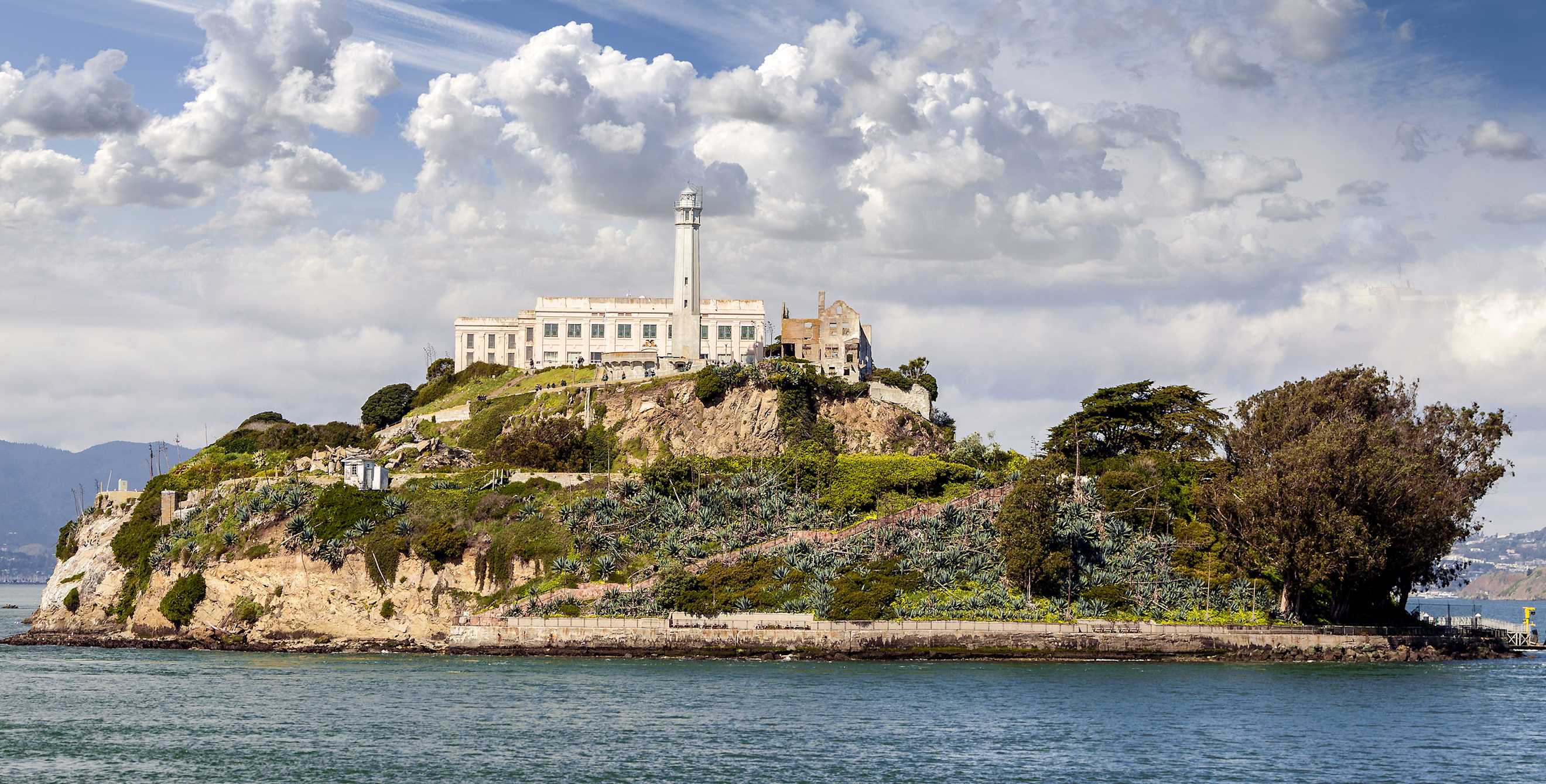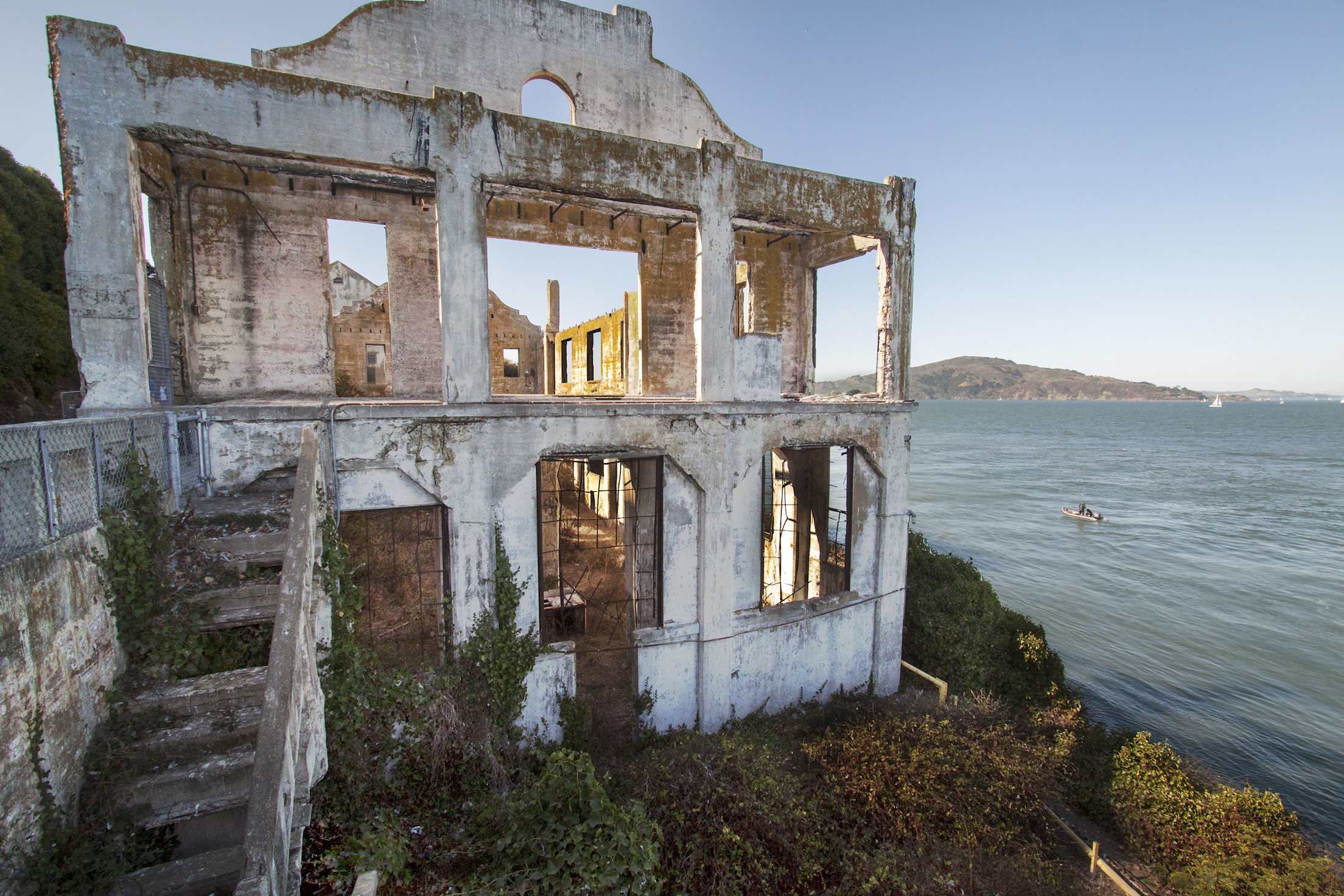
Tour Alcatraz Island in San Francisco
Take a tour of Alcatraz maximum-security prison, and hear tales about its infamous residents.

It was on Christmas of 1959, in the mess hall of the United States Penitentiary at Alcatraz, that Homer Clinton took a dislike to the prison's Christmas tree—a festively decorated reminder of the joy the men were missing. Clinton, an inmate known as the "Green Lizard" (because it was rumored he'd once swallowed one whole), walked over to the tree, picked it up, and headed down the center aisle. He was almost to the door before guards tackled him. But the Green Lizard wasn't finished tangling with the tannenbaum. The following year, the prison's would-be Grinch did the same thing. After that, prison officials decided that Clinton should spend Christmastime in solitary confinement.
The story, told by Alcatraz interpreter Jim Nelson, draws laughter from the tourists sitting in the mess hall now, 41 years after Alcatraz closed up shop as a maximum-security prison. Even amid the violence, the madness, and the boredom, Alcatraz has offered up its moments of humor—and, more than anything, its stories. The place is so rich in tales that Hollywood has been mining it for years, bestowing on the Rock a near-mythological status.
It's not just Hollywood producers, however, who want to steep themselves in Rock lore. Each year the island, which is 1.3 miles and a 10-minute ferry ride from San Francisco, draws 1.4 million tourists. In the summer, an average of 5,300 people visit daily while several thousand others are turned away. (Note to prospective sightseers: Call or go online at least 10 days in advance for reservations.)
Even after the National Park Service opened Alcatraz to the public in 1973, there was a fair share of uncertainty as to how many visitors the old prison would attract. Now, ferries disgorge tourists onto the island, and the cell house is filled with people listening, in six different languages, to tales of Al Capone, George "Machine Gun" Kelly, and the Birdman of Alcatraz on the prison's award-winning audio tour.

What to See on Your Alcatraz Tour
Visitors lucky enough to tour Alcatraz at night are escorted up the hill by a park interpreter, who gives brief talks along the way. And it's in these talks that you learn details of the inhumanely harsh conditions of the military prison—deserters were branded with a D—and the fact that Alcatraz had no source of freshwater (it still doesn't; water is brought over by boat).
The island's main draw, though, sits at the top of the hill: the towering former penitentiary, created in 1934 after the army withdrew and the newly minted Federal Bureau of Prisons moved in to oversee the first maximum-security facility in the United States.
From the beginning, the prison was surrounded by a fog of glamour and darkness. Why? "I think it was just that era, and that particular institution grabbed people's attention, " says John Paitakes, a professor of criminal justice at Seton Hall University. "Never before had the most violent and most noted criminals been housed in one institution."
The time was ripe for such a prison. It was the Depression era, a period when gangsters like Al Capone, Ma Barker, and Bonnie and Clyde terrorized the country, and the public wanted these criminals behind bars, far, far away. As for rehabilitation, it was all but nonexistent.
Experience History
Without a doubt, the best way to hear about the Rock's rich history is through the many programs offered by the park service. The rangers and docents who conduct the tours, such as Escapes and Hollywood's Alcatraz, are almost freakish in the depth of their knowledge. And the 35-minute-long audio tour, filled with the voices of former inmates and guards, helps to bring the cell house eerily to life.
What might you learn on these tours? For starters, that Capone, the prison's most famous inmate, was as unthreatening as a child during his 4½-year stay, while he slowly lost his mind to syphilis. Or that Robert "the Birdman of Alcatraz" Stroud—who never kept birds while at the Rock—was so hostile and violent that he spent his years in D Block solitary confinement and the hospital wind. (He was, according to interpreter Jim Nelson, "a disturber," likely to incite riots among his fellow prisoners.)
You'll also see the five-by-nine-foot cells in which inmates spent 23 hours a day (working and recreation yard time were privileges they had to earn) and hear tales of daring escape attempts, such as the one carried out by Frank Morris and the Anglin brothers, who placed dummy heads in their cots so they wouldn't be missed. The trio's ultimate fate remains unclear—it's been assumed that they drowned, but their bodies were never found.
The penitentiary was closed in 1963, due to the daily opertating costs and the expense of maintaining the facilities. Alcatraz sat vacant until November of 1969, when protesters occupied the island in an effort to draw attention to the treatment of American Indians by Congress and the Bureau of Indian Affairs. The 19-month occupation gained international attention and sparked the American Indian Movement in the United States. Eventually, authorities removed the remaining protesters and the island went silent once more.
It seems incongruous that Alcatraz teems with people now. The Rock's greatest asset has always been its isolation. There are still hints of its desolate nature: the thousands of birds that cling to its craggy cliffs, the mournful sound of passing boat horns, the salt-soaked wind that whips its stones and structures, the endless waters of the Bay.
For a taste of the forsaken Alcatraz, venture out of the cell house to the southern end of the island to view hundreds of western gulls, which nest here from February to September. Don't miss the waterfront Agave Trail, with the loveliest views of San Francisco to be found anywhere.
Alcatraz Night Tour
The evening tours offer the closest glimpse of what it was like to spend night after night locked up in a cell. With fewer people on the island after sundown, visitors get a greater sense of its desolation. The silence is almost eerie. But the city lights twinkle like a Christmas tree in the distance. And this, perhaps, in addition to the surfeit of great stories, is the key to Alcatraz's allure: darkness in the midst of so much beauty.
Certainly, it must have felt that way to the inmates on New Year's Eve as they listened to the sounds of revelers coming from the city. If the night was still, they could hear music, the clinking of glasses, the laughter of women—reminders of all they were denied. Jim Quillen, who was imprisoned at Alcatraz from 1942 to 1952, puts it best. "There was never a day," Quillen says on the audio tour, "you couldn't see what you were losing."
Best Movies About Alcatraz
Hollywood has been enamored of Alcatraz ever since the federal prison opened there in 1934. Its first Rock movie, Alcatraz Island (a forgettable tale about three inmates), debuted three years later. Here are a few of the Rock's more memorable cinematic treatments:
- Birdman of Alcatraz (1962) Sure, this movie received four Oscar nominations (including a best actor nod for Burt Lancaster), but it's a dubious tale at best. Not only did Robert Stroud not have birds while he was at the Rock, he was also a sociopath who wrote pornographic stories about young boys—hardly the gentle creature portrayed on-screen.
- Escape from Alcatraz (1979) This Clint Eastwood flick was based on the 1962 escape of Frank Morris and brothers John and Clarence Anglin. It's considered one of the finest prison films ever made, in a league with Papillon and The Shawshank Redemption.
- Murder in the First (1995) Although inspired by real-life events, this film is one of the least accurate Alcatraz stories—about an inmate who's placed in solitary confinement for years and then murders another prisoner. The cast includes Christian Slater, Kevin Bacon, Gary Oldman, and William H. Macy, but the movie drives Alcatraz historians nuts.
- The Rock (1996) Nicolas Cage, Sean Connery, and Ed Harris star in this action yarn about commandos taking hostages on Alcatraz and threatening to gas San Francisco. Lots of testosterone.